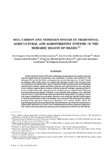Please use this identifier to cite or link to this item:
http://www.alice.cnptia.embrapa.br/alice/handle/doc/980525| Title: | Soil carbon and nitrogen stocks in traditional agricultural and agroforestry systems in the semiarid region of Brazil. |
| Authors: | SACRAMENTO, J. A. A. S. do  ARAÚJO, A. C. de M.   ESCOBAR, M. E. O.   XAVIER, F. A. da S.   CAVALCANTE, A. C. R.   OLIVEIRA, T. S. de   |
| Affiliation: | JOSÉ AUGUSTO AMORIM SILVA DO SACRAMENTO, UFRB; ANA CAROLINE DE MORAES ARAÚJO, UFC; MARIA EUGENIA ORTIZ ESCOBAR, UFC; FRANCISCO ALISSON DA SILVA XAVIER, CNPMF; ANA CLARA RODRIGUES CAVALCANTE, CNPC; TEÓGENES SENNA DE OLIVEIRA, UFV. |
| Date Issued: | 2013 |
| Citation: | Revista Brasileira de Ciência do Solo, v. 37, p. 84-795, 2013. |
| Description: | Abstract: In the semiarid region of Brazil, inadequate management of cropping systems and low plant biomass production can contribute to reduce soil carbon (C) and nitrogen (N) stocks; therefore, management systems that preserve C and N must be adopted. This study aimed to evaluate the changes in soil C and N stocks that were promoted by agroforestry (agrosilvopastoral and silvopastoral) and traditional agricultural systems (slash-and-burn clearing and cultivation for two and three years) and to compare these systems with the natural Caatinga vegetation after 13 years of cultivation. The experiment was carried out on a typical Ortic Chromic Luvisol in the municipality of Sobral, Ceará, Brazil. Soil samples were collected (layers 0-6, 6-12, 12-20, 20-40 and 40-60 cm) with four replications. The plain, convex and concave landforms in each study situation were analyzed, and the total organic C, total N and densities of the soil samples were assessed. The silvopastoral system promoted the greatest long-term reductions in C and N stocks, while the grosilvopastoral system promoted the smallest losses and therefore represents a sustainable alternative for soil C and N sequestration in these semiarid conditions. The traditional agricultural system produced reductions of 58.87 and 9.57 Mg ha-1 in the organic C and total N stocks, respectively, which suggests that this system is inadequate for these semiarid conditions. The organic C stocks were largest in the concave landform in the agrosilvopastoral system and in the plain landform in the silvopastoral system, while the total N values were highest in the concave landform in the native, agrosilvopastoral and silvopastoral systems. Na região semiárida, o manejo inadequado dos sistemas de cultivo, aliado à baixa produção de fitomassa, pode contribuir para reduzir os estoques de carbono (C) e nitrogênio (N) do solo; portanto, a adoção de sistemas de manejo para a preservação desses elementos é necessária. Objetivou-se avaliar as alterações promovidas nos estoques de C e N do solo por sistemas agrícolas agroflorestais (agrossilvipastoril e silvipastoril) e tradicional (com derrubada da vegetação, queima e cultivo por dois-três anos), confrontando-os à vegetação natural de Caatinga, após 13 anos, em experimento instalado em um Luvissolo Crômico órtico típico, no município de Sobral, Ceará. Amostras de solo foram coletadas nas profundidades de 0-6, 6-12, 12-20, 20-40 e 40-60 cm, em quatro repetições, considerando os relevos plano, convexo e côncavo em cada situação de estudo, sendo determinados o C orgânico total, o N total e as densidades do solo. Entre os sistemas agroflorestais estudados, o silvipastoril, em longo prazo, promoveu as maiores reduções nos estoques de C e N, enquanto o agrossilvipastoril as menores perdas, representando alternativa sustentável para o sequestro de C e N do solo nessas condições semiáridas. O sistema de cultivo tradicional apresentou reduções de 58,87 e 9,57 Mg ha-1 dos estoques de C orgânico e N total, respectivamente, indicando sua não adequação para as condições semiáridas brasileiras. Os relevos côncavo, no sistema agrossilvipastoril, e plano, no silvipastoril, apresentaram os maiores estoques de C orgânico, enquanto para o N total, a forma côncava apresentou os maiores valores na vegetação nativa, agrossilvipastoril e silvipastoril. |
| Thesagro: | Manejo do solo Caatinga Recurso natural |
| NAL Thesaurus: | Silvopastoral systems Carbon sequestration Soil management Brazil Semiarid soils |
| Keywords: | Agricultura itinerante Sistemas agroflorestais Sequestro de carbono Manejo conservacionista Sistema agrossilvipastoril Agrosilvopastoral systems Agroecologia Agroforestry systems |
| Notes: | Título em português: Estoques de carbono e nitrogênio do solo em sistemas agrícolas tradicional e agroflorestais no Semiárido brasileiro. |
| Type of Material: | Artigo de periódico |
| Access: | openAccess |
| Appears in Collections: | Artigo em periódico indexado (CNPC)  |
Files in This Item:
| File | Description | Size | Format | |
|---|---|---|---|---|
| APISoilcarbonandnitrogen.pdf | 542.98 kB | Adobe PDF |  View/Open |









